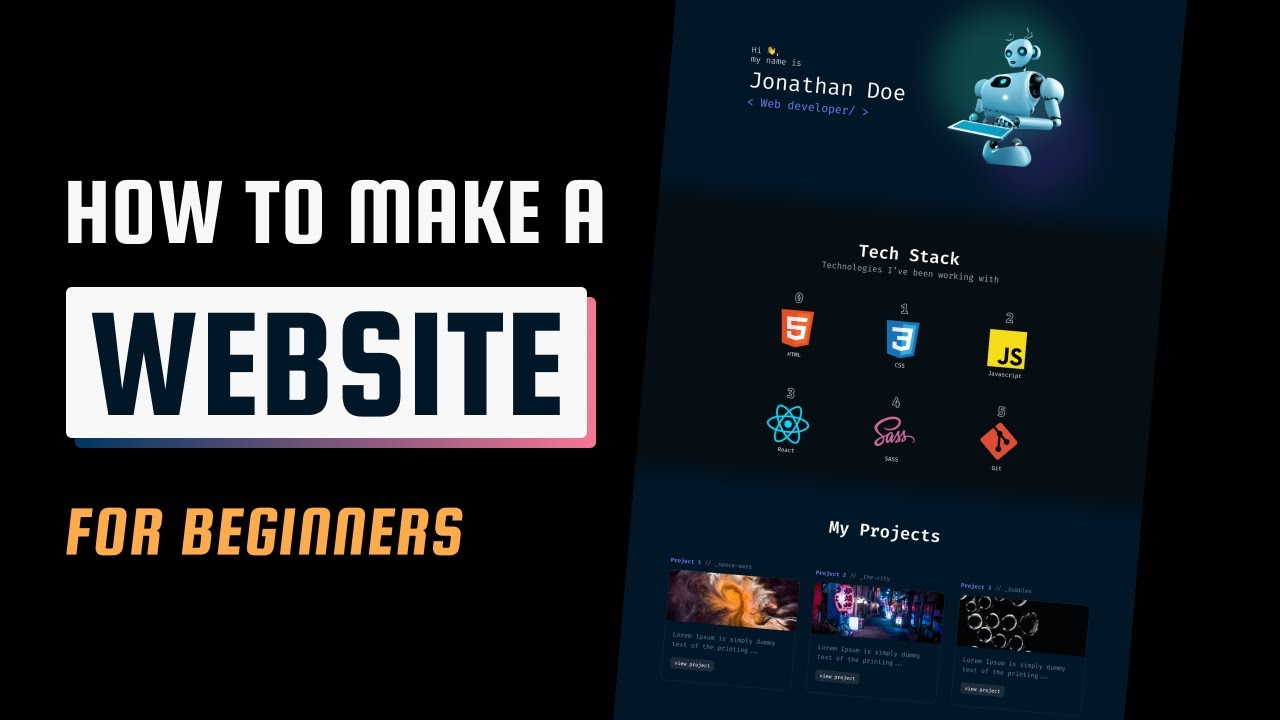In the world of web development, HTML and CSS are the building blocks for creating websites. If you're a beginner looking to dive into web development, learning how to create a simple website using HTML and CSS is the perfect place to start. In this guide, we'll walk you through the process of building a basic website in just 30 minutes. Let’s get started!
Step 1: Set Up Your Project
Before diving into the code, you need to create a folder on your computer where your project files will live. You can name this folder “MyFirstWebsite” or anything you like.
Inside the folder, create two files:
-
index.html– This is where the content of your website will go (HTML). -
styles.css– This will control the design and layout of your website (CSS).
Now that you have your project set up, let’s start writing some code!
Step 2: Write Your HTML Code
HTML (HyperText Markup Language) is the language used to structure your website's content. Start by opening the index.html file in a text editor (like Visual Studio Code, Sublime Text, or even Notepad).
Here’s a simple template to begin with:
<!DOCTYPE html>
<html lang="en">
<head>
<meta charset="UTF-8">
<meta name="viewport" content="width=device-width, initial-scale=1.0">
<title>My First Website</title>
<link rel="stylesheet" href="styles.css">
</head>
<body>
<header>
<h1>Welcome to My First Website!</h1>
</header>
<section>
<h2>About Me</h2>
<p>This is a simple website I created using HTML and CSS.</p>
</section>
<section>
<h2>My Hobbies</h2>
<ul>
<li>Coding</li>
<li>Reading</li>
<li>Traveling</li>
</ul>
</section>
<footer>
<p>© 2025 My First Website</p>
</footer>
</body>
</html>
Let’s break it down:
-
The
<!DOCTYPE html>tag defines the document type and version of HTML. -
The
<html>tag surrounds everything on the page, and thelang="en"attribute specifies the language (English). -
Inside the
<head>section, we include metadata about the website like the character set and viewport settings for mobile devices. We also link to thestyles.cssfile. -
The
<body>section contains the visible content of your website, including a header, sections with headings, text, and a footer.
Step 3: Add Styles with CSS
CSS (Cascading Style Sheets) is used to style the HTML content, making it look attractive and visually engaging. Open your styles.css file in the text editor and add the following code:
/* Reset some default styles */
body, h1, h2, p, ul {
margin: 0;
padding: 0;
}
/* Set the background color and font for the whole page */
body {
font-family: Arial, sans-serif;
background-color: #f4f4f4;
color: #333;
}
/* Style the header */
header {
background-color: #4CAF50;
color: white;
padding: 20px;
text-align: center;
}
/* Style for the main sections */
section {
margin: 20px;
padding: 20px;
background-color: white;
border-radius: 5px;
}
/* Style the footer */
footer {
text-align: center;
padding: 10px;
background-color: #333;
color: white;
}
/* Add some spacing between list items */
ul {
list-style-type: none;
padding: 0;
}
ul li {
margin: 5px 0;
}
Here's a breakdown of the CSS:
-
We begin by resetting some default styles that browsers apply to elements like headings and paragraphs.
-
We then define styles for the body of the page, such as the background color, font, and text color.
-
The header section is given a green background with white text, and it's centered.
-
Each section has padding and a white background, along with rounded corners.
-
The footer has a dark background and white text to create contrast.
Step 4: Preview Your Website
Now that you’ve written both the HTML and CSS code, it’s time to see your website in action!
-
Save both
index.htmlandstyles.cssfiles. -
Open the
index.htmlfile in your web browser (simply double-click it). -
Voila! You should see a simple webpage with a green header, a couple of sections about hobbies, and a footer.
Step 5: Customize and Enhance
Congratulations! You’ve just built a basic website using HTML and CSS. Now, it’s time to customize it further:
-
Change the content: Update the text and sections to reflect your own personal information or interests.
-
Add more styling: Play around with font styles, colors, and layouts. You can also add images or links to make your site more interactive.
-
Experiment with layout: Use CSS techniques like Flexbox or Grid to create more advanced layouts.
Conclusion
Building a website with HTML and CSS is the first step towards becoming a web developer. By following these simple steps, you’ve learned how to create a basic webpage that you can customize and expand upon. As you continue learning, you’ll be able to add more features and create even more dynamic and complex websites.
The key to mastering web development is practice, so keep experimenting, and in no time, you’ll be building professional-quality websites!

